- Bitcoin holds steady above $115K as supply diminishes and strong on-chain accumulation occurs, indicating a possible breakout in November.
- Ethereum hovers around $4,100 as Layer 2 adoption, staking interest, and deflationary dynamics support sustained growth.
- The rapid network of Solana and its expanding ecosystem support ongoing recovery, as reduced volatility suggests a potential surge past $200.
- XRP picks up speed as Ripple’s institutional pathways broaden, turning the token into a conduit for worldwide cross-border transactions.
- Cardano ensures steady growth, backed by substantial staking, Hydra Layer 2 scalability, and governance-led adoption of functional applications
Bitcoin (BTC)
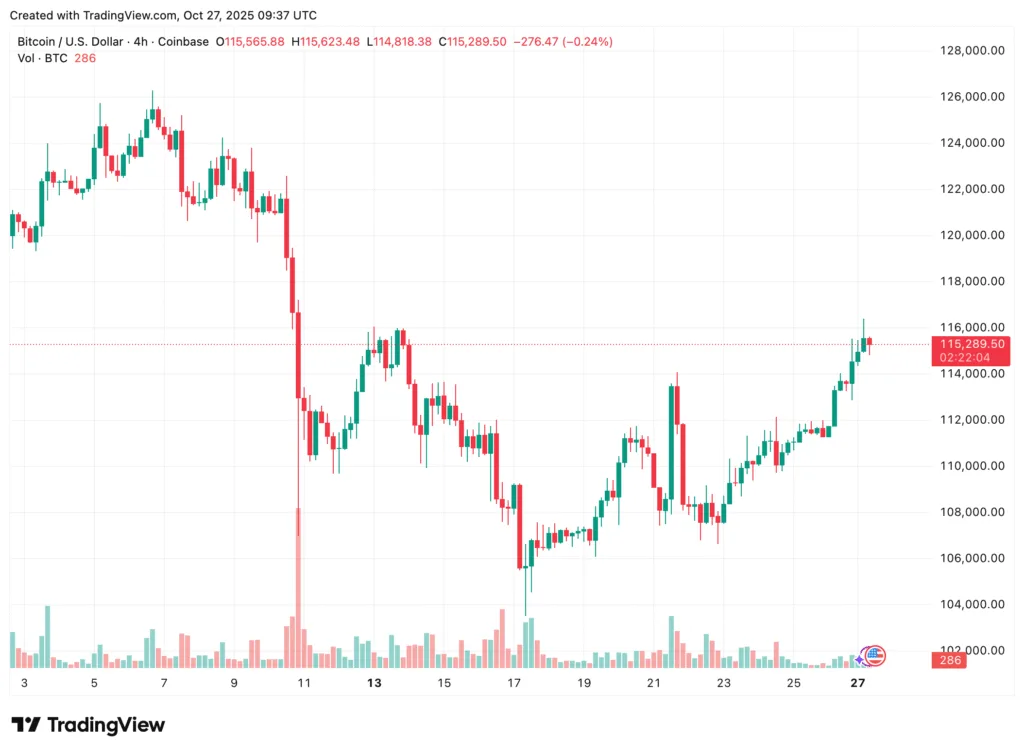
Market overview
Bitcoin began the last week of October 2025 with confidence, trading solidly above one hundred fifteen thousand dollars and reasserting its role as the market’s guide after weeks of shifting sentiment. The sentiment among major exchanges has transitioned from carefulness to understated assurance. Institutional portfolios that had cut back exposure until early October are now gradually increasing, while retail traders, encouraged by the market’s strength, are starting to reengage with careful optimism.
This recovery is occurring amid a context of worldwide macro stabilization. U.S. bond yields have decreased from their recent peaks, the dollar index has softened, and risk assets, including stocks and commodities, are regaining strength. Under these circumstances, Bitcoin’s role as a blend of digital asset and macro protection has reemerged. The story has once more expanded from conjecture to tactical gathering.
On-chain fundamentals are strengthening this trend. The overall Bitcoin hash rate stays at all-time highs, demonstrating miners’ assurance in the network’s profitability even with high energy expenses. The percentage of Bitcoin supply kept for over six months has risen to a record high, exceeding seventy percent of all coins in circulation. This fixed supply base acts as the foundation of the market, decreasing liquidity on exchanges and indicating long-term confidence while short-term traders persist in probing both extremes of the range.
Newsletter
Get weekly updates on the newest crypto stories, case studies and tips right in your mailbox.
Technical structure
Bitcoin’s technical configuration during October has demonstrated a pattern of consolidation amid strength. Following a local peak around one hundred twenty-five thousand dollars in early October, the price pulled back to the one hundred ten to one hundred twelve thousand range, where it encountered consistent support. That area has evolved into a strong accumulation zone, undergoing several tests from underneath and forming the basis of the ongoing recovery phase.
The larger chart layout indicates a market at balance. Daily candlesticks indicate tightening volatility bands as traders anticipate validation of the upcoming directional shift. The moving averages show a strong alignment: the fifty-day line stays positioned above the hundred-day, and both are well above the two-hundred-day mark. This enduring framework highlights the continuation of the main upward trend despite temporary consolidation.
Momentum oscillators like the relative strength index stay neutral to somewhat bullish, lingering in the mid-fifties a position that supports additional gains without indicating overextension. At the same time, the MACD indicator is starting to turn upward after weeks of downward pressure, suggesting that a possible bullish crossover may occur if the price continues on its present path. The relationship between increasing volume on ascending candles and decreasing volume during pullbacks implies that accumulation remains ongoing beneath the surface.
On-chain and macro context
Beyond price charts, the fundamental data reveals a narrative of structural tightening and tactical distribution. The reserves of Bitcoin on exchanges have dropped to their lowest point in over six years, indicating that there are fewer coins available for sale. The reduction in liquid supply serves as a pressure release for future volatility; when demand resurfaces, restricted supply can significantly enhance upward shifts.
The involvement of institutions continues to be a characteristic aspect of the present cycle. In October alone, exchange-traded products centered around Bitcoin in North America and Europe attracted over one billion dollars in net inflows. The arrival of these inflows aligns with increasing optimism that inflationary pressures are subsiding and that central banks might soon shift to more supportive policies. With traditional investors looking for varied access to tangible assets, Bitcoin’s limited supply and programmable nature provide a distinctive safeguard against monetary devaluation and geopolitical risks.
Miner actions also offer important perspective on sentiment. Instead of selling during periods of high prices, miners have been net buyers for the majority of the month, channeling block rewards into long-term reserves rather than exchanges. This aligns with the historical trend prior to halving, where miners accumulate reserves in expectation of upcoming supply decreases. The upcoming halving, set for mid-2026, already casts a shadow over the market narrative, introducing a cyclical aspect of scarcity to Bitcoin’s long-term value proposition.
On the macro front, a gradually improving geopolitical situation, especially revived advancements in U.S.–China trade talks, has introduced a slight risk-on sentiment in global markets. When equity indices increase and credit spreads narrow, Bitcoin usually gains from the same liquidity drive. The asset’s capacity to draw in both risk-loving investors and protective hedges at the same time highlights its changing function in worldwide portfolios: partly a commodity, partly a technology, and more frequently, partly a macro tool.
Market sentiment and liquidity dynamics
Market sentiment has experienced a subtle shift since early October. Funding rates, which had fallen into negative levels during the mid-month adjustment, have now returned to normal. Derivatives data indicates a drop in leveraged short positions along with an increase in long open interest, implying that traders anticipate a sustained upward trend.
Liquidity assessment on key exchanges shows that buyers have solidified their position around the one hundred ten thousand mark, whereas resting sell orders are focused around one hundred twenty and one hundred twenty-three thousand. This distribution establishes the market’s immediate conflict zone. If the price breaks clearly past that resistance, stop orders and breakout algorithms may drive a swift movement toward one hundred thirty thousand and higher.
The mental effect of this spectrum cannot be overlooked. Bitcoin’s fluctuation between one hundred ten and one hundred twenty thousand has fostered a sense of stability at price levels once deemed unimaginable. What used to be a speculative landmark is now a consolidation area, indicating the market’s maturity and its growing ease with elevated valuations.
Outlook and forecast
As November approaches, Bitcoin’s path appears carefully poised between consolidation and continuation. If the asset can stay stable above one hundred fifteen thousand and break through the resistance zone around one hundred twenty thousand, momentum is probably set to increase towards the one hundred thirty thousand range. This trajectory mirrors past cycle patterns where Bitcoin, having formed a mid-cycle foundation, surged significantly in the year’s final quarter.
If volatility returns and the price falls below one hundred ten thousand, focus will turn to the hundred thousand mark as the next significant support area. A decline to that level wouldn’t automatically negate the overall uptrend; instead, it might act as a more extensive liquidity sweep prior to fresh accumulation. The overarching narrative, especially changes in interest-rate policy and global liquidity, will dictate if these pullbacks turn into buying opportunities or trend reversals.
Currently, the market’s framework, mood, and on-chain metrics all lean slightly positive. Bitcoin’s ability to maintain high values despite macroeconomic uncertainty reflects its increasing acceptance by institutions and its shift from a speculative asset to a strategic investment. In numerous respects, Bitcoin has evolved into the gauge of contemporary risk appetite: when it stabilizes, trust within the crypto ecosystem grows; when it falters, liquidity withdraws from the whole digital asset market.
Currently, the king of crypto maintains its position not via explosive surges but rather through steady discipline. This phase of regulated strength, bolstered by dwindling supply and consistent inflows, might serve as the subtle groundwork for the upcoming significant expansion phase that could mark the end of 2025.
Ethereum (ETH)
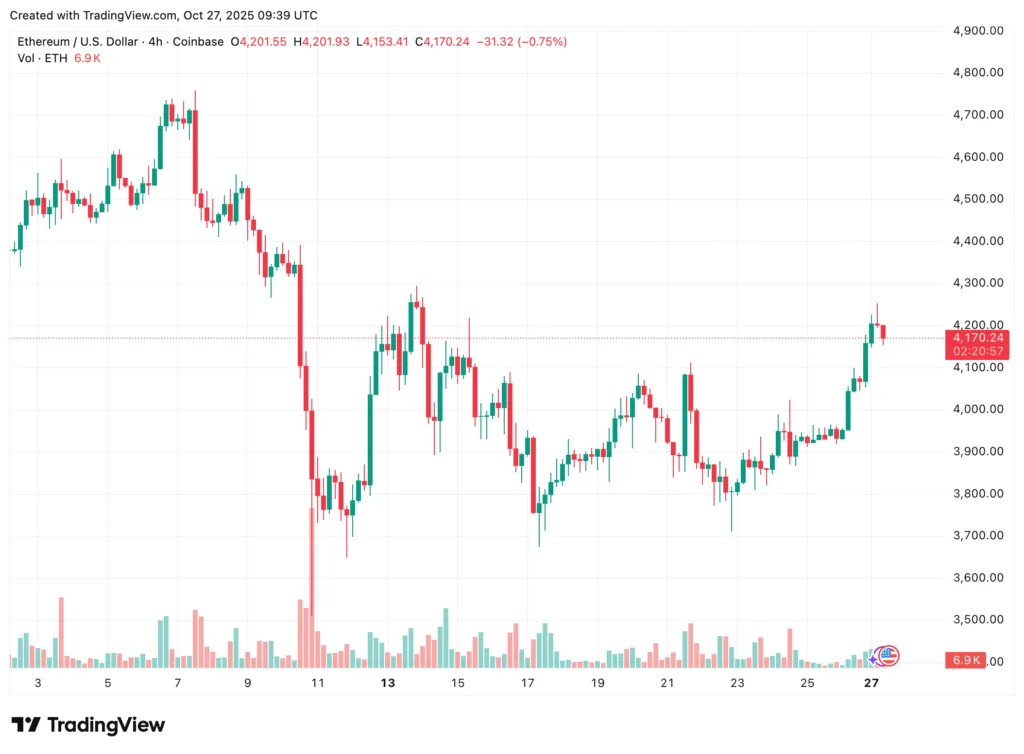
Market overview
Ethereum has reached the last quarter of 2025, finding itself again at the heart of the decentralized economy. Trading around four thousand one hundred dollars, ETH has shown a calm strength that differs from the more erratic pace of Bitcoin. Although Bitcoin’s function as a store of value remains a focal point in news, Ethereum has preserved its status as the backbone of on-chain innovation driving smart contracts, decentralized finance, and the fast-developing landscape of tokenized assets and AI-integrated protocols.
Following a short downturn in early October, Ethereum stabilized near three thousand eight hundred dollars, solidifying its position with the overall market rebound. Institutional investors have demonstrated revived interest via spot ETF inflows and increased involvement in ETH-based staking products. The endorsement of various regulated staking options in Europe and Asia has added a new dimension of credibility to Ethereum’s yield-generating capability, setting it apart from solely speculative altcoins.
This market landscape has enabled Ethereum to evolve into a dual-asset framework: one that operates as both a productive capital asset and a deflationary commodity. The ongoing destruction of ETH via transaction fees, along with its staking demand, has established a distinctive equilibrium of scarcity and utility that few digital assets can emulate.
Technical structure
The price chart of Ethereum indicates a consistent accumulation stage instead of a volatile spike. After the mid-October decline, ETH has continued to show an ascending triangle pattern on the daily chart, creating higher lows above three thousand seven hundred dollars and a resistance line that is horizontal at around four thousand two hundred. This setup usually signifies consolidation amid a prevailing uptrend, indicating possible continuation if the resistance level is decisively broken.
The fifty-day moving average has served as active support over the last month, currently positioned close to three thousand nine hundred. The hundred-day average lags just a bit, supporting the fundamental bullish sentiment. The MACD indicator has recently stabilized, suggesting that downward momentum is depleted and the next directional move may favor the upward side. In the meantime, volume activity has been steady yet limited, indicating a buildup of patience rather than reckless speculation.
A notably significant observation is the volatility compression evident on the Bollinger Bands. The constriction of the bands in the last three weeks indicates an upcoming expansion phase, typically followed by significant directional shifts. Historically, when Ethereum’s volatility decreases to comparable levels, it often precedes important breakouts linked to macro or ecosystem factors.
On-chain activity and network fundamental
Ethereum’s on-chain activities indicate a platform that remains robust despite fluctuations in price. Daily transaction totals stay close to their annual peaks, averaging 1.3 million each day, as Layer 2 networks built on Ethereum like Arbitrum, Optimism, and Base achieve new throughput milestones. Together, these scaling solutions currently handle a greater volume of transactions than Ethereum’s mainnet, while still finalizing their states on it, strengthening Ethereum’s position as the economic and security backbone of the decentralized web.
The shift to proof-of-stake, fully finalized in the last cycle, has turned Ethereum into a yield-producing environment. More than thirty million ETH are currently locked in staking contracts, which effectively decreases the circulating supply and raises the fundamental demand for the asset. With yields varying from three to five percent each year, Ethereum has transformed into a hybrid financial asset that serves as both infrastructure and a yield-generating digital bond.
Deflationary mechanisms persist in strengthening Ethereum’s supply-side story. The EIP-1559 fee burn mechanism actively removes thousands of ETH from circulation daily during times of high network activity. October has seen a net burn surpassing one hundred thousand ETH, enhancing the asset’s long-term scarcity outlook. With the growth of network usage driven by decentralized finance and tokenized physical assets, this deflationary trend reinforces Ethereum’s position as the most economically dynamic blockchain.
Ecosystem and technological momentum
The robustness of Ethereum’s market reflects the vitality of its ecosystem. In recent months, projects involving enterprise-level tokenization have surged, as leading financial institutions utilize Ethereum-based systems to release bonds, carbon credits, and tokenized treasury products. The emergence of on-chain funds administered through smart contracts highlights Ethereum’s increasing impact in regulated finance.
Simultaneously, Ethereum remains the experimental platform for decentralized applications powered by AI. Self-learning liquidity managers, autonomous trading bots, and AI-enhanced prediction systems are progressively developed on Ethereum or its Layer 2 extensions. This convergence of machine intelligence and decentralized infrastructure makes Ethereum the programmable foundation for the upcoming stage of digital economies.
Advancements in technology continue to be robust. The anticipated “Verkle Tree” upgrade, scheduled for 2026, intends to decrease data storage needs and enhance node performance, facilitating more scalable and lighter clients. This enhancement comes after the effective deployment of proto-danksharding in early 2025, which significantly lowered transaction costs for rollups. The network’s unceasing innovation cycle sets Ethereum apart from rivals that typically depend on temporary speed enhancements lacking equivalent decentralization or developer expertise.
Market sentiment and liquidity flow
Since mid-October, the sentiment around Ethereum has consistently gotten better. Depth in the spot market across key exchanges has risen, indicating that liquidity providers are returning to the market in anticipation of possible year-end events.
Funding rates have returned to a slightly positive range after several weeks of stability, reflecting a managed yet hopeful outlook among leveraged traders. The ETH/BTC pair, a frequently monitored gauge of relative strength, has settled close to its six-month average, indicating that the capital shift between the two leaders is balanced instead of competitive. This balance illustrates the evolving relationship between Bitcoin and Ethereum: one serves as a reserve asset, while the other acts as a technological foundation that consistently shapes the limits of programmable finance.
Retail traders are showing renewed interest, although it lacks the speculative excitement of previous cycles. Participation has focused on staking platforms, yield aggregators, and NFT-related utilities instead of short-term leverage. The market’s tone focuses less on hype and more on practicality, indicating that Ethereum’s user base has become more sophisticated as time has passed.
Outlook and forecast
Ethereum begins November with market attention centered on two intersecting themes: its involvement in institutional tokenization and its ability for technical scalability. The price stays confined within a narrowing pattern that may break out suddenly in either direction. A clear breakthrough above four thousand two hundred dollars may trigger momentum toward four thousand eight hundred and potentially revisit the psychological five-thousand-dollar mark that limited earlier cycles.
Should macro uncertainty return or Bitcoin’s dominance increase, observing a retest of the three thousand eight hundred area would be crucial for identifying structural support. Due to Ethereum’s strong presence in decentralized finance and its growing application in tokenized assets, any setbacks are expected to draw in strategic buyers instead of causing panic among sellers.
From a wider viewpoint, Ethereum serves as the foundational core of Web3. Its deflationary structure, along with ongoing innovation and increasing institutional adoption, implies that its long-term path is still secure. In contrast to previous cycles fueled by speculative enthusiasm, Ethereum’s growth narrative for 2025 is grounded in fundamentals such as genuine users, tangible yield, and actual demand for decentralized computing.
As the network gears up for further technical enhancements and institutional integration, Ethereum’s transition from a platform to an economic protocol remains central to its identity. It’s not just the world’s computer anymore; it’s evolving into the world’s settlement layer, connecting traditional finance and digital independence in ways that are just starting to be revealed.
Solana (SOL)
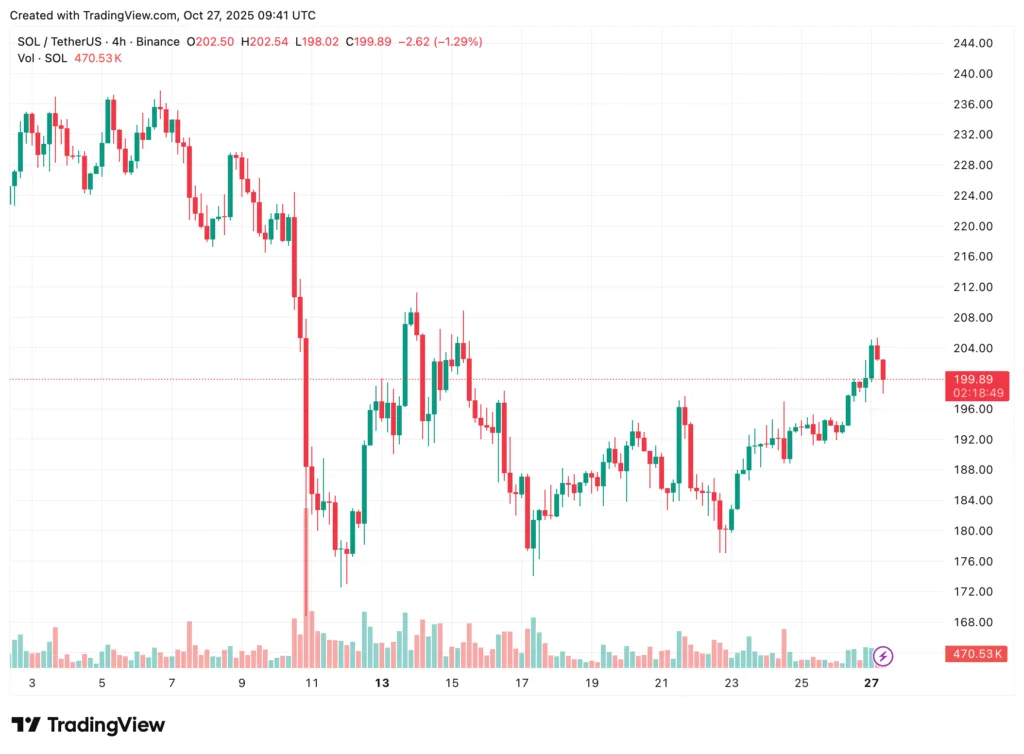
Market overview
Solana’s revival in the fourth quarter of 2025 signifies one of the most notable returns in the digital asset industry. Currently trading at approximately $190, SOL has not only bounced back from the volatility that characterized its initial years but has also established itself as the quickest-growing Layer 1 network beyond Ethereum’s influence. Its capacity to sustain high throughput while preserving user experience has made it a preferred platform for developers creating consumer-level decentralized applications, including trading bots, gaming ecosystems, and payment infrastructures.
The performance in October demonstrated this consistency. Following a slight drop to $175 in the second week of the month, Solana quickly recovered, regaining the $190 mark due to robust spot demand and continuous inflows from retail investors. In contrast to earlier rallies fueled by speculative excitement, the current cycle’s resilience arises from stronger fundamentals: retention of developers, increasing revenue within the ecosystem, and practical use cases extending beyond DeFi into actual payment systems.
Solana’s main appeal of high performance and minimal latency keeps drawing in developers who prioritize scalability and almost zero transaction fees. This operational benefit has fostered a setting where AI-powered applications and high-frequency trading systems flourish. While other networks face congestion or increasing costs, Solana has emerged as a reliable, efficient foundation for decentralized consumer applications.
Technical structure
The technical framework of Solana’s chart shows a robust uptrend supported by regular higher lows and orderly volume allocation. The asset has been trading in a distinct upward channel since late August, showing dynamic support at approximately $178 and resistance close to $196. These limits have been examined numerous times, showing robust liquidity at both extremes, indicating a stable and assured market.
The fifty-day exponential moving average (EMA) is presently around $182, serving as an important point for price consolidation, while the hundred-day EMA is at $171, offering further structural support. The Relative Strength Index (RSI) stays neutral near 58, indicating that Solana has potential for upward growth without indicating overextension.
Importantly, the volatility profile for October has narrowed, reflecting the situation observed in early August prior to Solana’s 35% surge. The Bollinger Bands are constricting once more, and the open interest in derivatives has risen by about 12% over the last ten days. This combination usually indicates that traders are getting ready for a directional shift, with a strong likelihood of upward momentum if Bitcoin stays steady and market liquidity keeps enhancing.
Short-term resistance is at $198, the mark that constrained Solana’s previous significant rally, while a surge past $200 would indicate a fundamental change towards a more intense growth phase. The extended goal, if momentum persists, is within the $225–$240 range, aligning with the upper Fibonacci retracement from the peak of the 2021 cycle.
On-chain performance and network health
Apart from the graphs, Solana’s on-chain metrics illustrate a scenario of strong and persistent network engagement. Since September, daily active addresses have stayed above one million, and total transactions have consistently surpassed fifty million per day, significantly leading in throughput compared to other major Layer 1 networks. This consistency highlights Solana’s transformation from a speculative network to a viable digital framework for millions of users.
The network’s availability, previously a contentious topic, has demonstrated significant enhancement. Following the 2024 validator upgrade, Solana has functioned for more than 320 straight days without any major outages, reinstating trust among developers and institutional partners. The introduction of regional fee markets and the Firedancer validator client, created in partnership with Jump Crypto, has greatly improved network resilience. As Firedancer enters its final testing stages, Solana’s potential throughput may soon surpass one million transactions per second a technological achievement that would elevate blockchain efficiency to new heights.
Solana’s decentralized exchanges (DEXs) and DeFi protocols are witnessing a resurgence in volume growth at the financial level. Platforms like Jupiter, Raydium, and Orca have collectively achieved more than $20 billion in monthly transaction volume. At the same time, Solana’s NFT ecosystem continues to thrive, with a greater emphasis on utility rather than speculation. Initiatives such as Tensor and Solana Saga integrations are transforming the interaction of digital assets with mobile and AI environments.
Arguably most significantly, Solana Pay, the network’s practical payment solution, is increasingly being adopted by merchants and fintech companies in developing markets. Transaction finality gauged in milliseconds and minimal fees offer a significant competitive edge for enterprises engaged in high-frequency microtransaction settings.
Ecosystem expansion and innovation
Solana’s ecosystem has evolved into one of the most varied in the crypto industry, marked by advancements in both application and infrastructure. In October, several AI startups incorporated Solana for efficient data processing and on-chain inference, establishing the network as a center for the convergence of artificial intelligence and decentralized technologies. The AI Agent Network, designed on Solana’s runtime framework, enables developers to implement autonomous trading and analytics bots that can analyze on-chain signals in real time, a scenario drawing interest from both quantitative funds and algorithmic traders.
Simultaneously, Solana’s gaming and entertainment sectors are experiencing swift user expansion. Games such as Star Atlas and Aurory are continuing to grow their user communities by incorporating mobile and VR features. The chain’s ability to handle a high volume of transactions allows game developers to integrate in-game assets, on-chain trading, and player economies without experiencing delays. This creates a distinct position for Solana: it’s not in direct competition with Ethereum for DeFi supremacy but is concentrating on enhancing user experience and scalability in consumer-oriented digital markets.
The flow of venture capital continues to be strong. Even with a more subdued fundraising climate in the overall crypto space, projects on Solana secured more than $120 million in seed and Series A funding during Q3 2025. These funding infusions have been focused mainly on infrastructure development, gaming middleware, and inter-chain liquidity options, showcasing investor trust in Solana’s future growth.
Market sentiment and liquidity landscape
Investor sentiment regarding Solana has significantly changed since its tumultuous history. The once-ethereal image that troubled the network has mostly diminished, substituted by an understanding of technical dependability and developer skill. Market liquidity continues to be robust, bolstered by increasing institutional participation via structured products and staking derivatives.
In mid-October, Solana’s total value locked (TVL) exceeded $18 billion, marking its peak since 2022. This revival in DeFi engagement shows that users are not just transacting but also placing their trust in the network with long-term capital investments. The typical transaction fee stays under $0.001, highlighting Solana’s cost-efficiency compared to its rivals.
In derivatives markets, Solana’s perpetual futures funding rates have remained neutral to somewhat positive, indicating balanced leverage scenarios. The rise in open interest coupled with subdued funding suggests that institutional investors are discreetly building their positions instead of pursuing short-term surges. This regulated conduct is usually linked to sustainable growth patterns instead of speculative bubbles.
On social sentiment trackers, references to Solana-related ecosystems, especially Solana Pay, Firedancer, and AI Agents, have risen by almost 30% month-over-month. This increase indicates a resurgence of community involvement linked to real achievements instead of hype-fueled trends.
Outlook and forecast
Solana begins November 2025 in a state of strategic advancement. Its ecosystem is now characterized by the stability of its technology and the trustworthiness of its developers rather than by volatility or experimental narratives. The network’s transition from a fast alternative to Ethereum into an independent digital economy represents one of the most important changes in recent blockchain history.
Moving forward, the primary emphasis will be on the launch of Firedancer, which has the potential to set new standards for speed and robustness in the industry. If the upgrade goes well, Solana could draw in a new surge of enterprise-level applications that demand high transaction throughput, such as real-time gaming, AI trading systems, and cross-border micropayment options.
From a pricing standpoint, Solana’s optimistic trend stays valid as long as it holds support above $175. A confirmed rise above $200 would probably initiate momentum toward the $220 area. Should macro conditions stay positive and liquidity keeps shifting from Ethereum Layer 2s to Solana-specific protocols, the asset might revisit its all-time high in the upcoming six months.
However, Solana’s true success is not in its price movement but in the credibility it has gained. It has been demonstrated that scalability and decentralization can coexist, and that user-centric innovation can align with institutional-level performance. With the convergence of AI, automated trading, and Web3 commerce, Solana now occupies a pivotal position transitioning from an underdog to a vital element in the emerging era of decentralized systems.
XRP (Ripple)
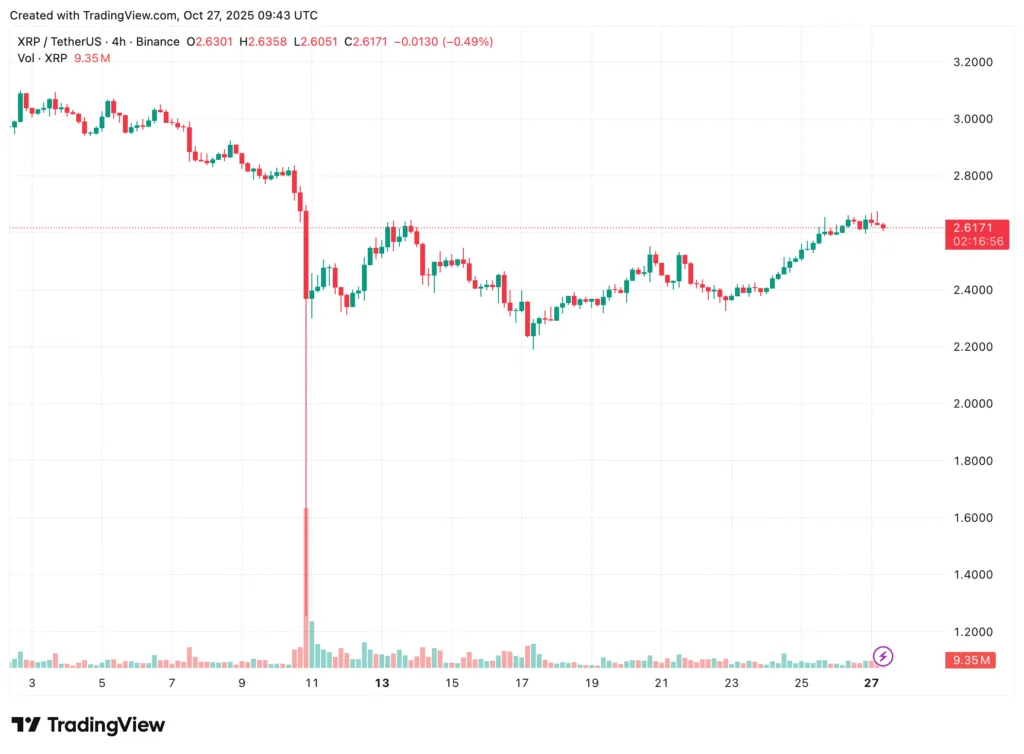
Market overview
XRP’s narrative in October 2025 involves a subtle comeback and renewed interest from institutions. Trading at approximately $0.63, XRP has captured market interest again as Ripple’s cross-border payment system broadens its global reach into new financial pathways. Following years of regulatory ambiguity, the asset has reached a stage of fundamental stability, now characterized not by legal risks but by the slow fulfillment of its initial goal: linking the world’s disparate payment systems into a cohesive liquidity layer.
The last month experienced a 9% rise in price, which is small relative to Bitcoin and Ethereum but important due to its structural consequences. The primary element driving XRP’s renewed momentum is the institutional pipeline Ripple has reestablished throughout 2025. An increasing number of banks and payment service providers throughout Asia, the Middle East, and Latin America have adopted RippleNet and its On-Demand Liquidity (ODL) service for instant settlements. The outcomes are starting to emerge in transactional volume, lending legitimacy to the utility narrative of XRP, which is finally separating from solely speculative trends.
Following an extended phase of inactivity, the asset’s market sentiment appears significantly transformed. XRP’s price movement is now influenced by a measured resurgence linked to usage, corporate adoption, and regulatory normalization, instead of being propelled by hype or short-term events.
Technical structure
XRP’s technical structure depicts a scenario of slow accumulation after an extended period of base formation. The asset has been fluctuating within a wide range of $0.57 to $0.67 since mid-September, creating a symmetrical triangle on the daily chart. This formation frequently signifies a market poised for validation prior to growth, illustrating a blend of careful positivity and constrained fluctuations.
Support is firmly established around $0.58, a point that has consistently served as a demand zone in previous corrections. Resistance stands at $0.67, the upper limit that has thus far limited upward movements. A move above this resistance might clear the way to the $0.72 area, aligning with the subsequent liquidity cluster on the weekly chart. Conversely, a drop below $0.57 might initiate short-term liquidations, yet strong structural support persists as the asset stays above $0.54 its 100-day moving average.
From a momentum standpoint, the RSI is presently around 52, indicating equilibrium instead of fatigue. Volume has remained low yet consistent, indicating reliable institutional involvement without excessive speculation. The moving averages display a strong compression pattern: the 50-day line nearing the 100-day line, frequently indicating an upcoming trend change. If a bullish crossover takes place, it may signal the start of a wider recovery trend as we approach the last quarter of the year.
The key insight from the chart is that XRP’s present stage is not aggressive but rather constructive, marked by a gradual, intentional accumulation phase that may support a more stable progression in the upcoming months.
On-chain and institutional metrics
The robustness of XRP has consistently been linked to its integration with institutions, and that trend is once more unfolding. Ripple’s current collaborations with international financial entities have progressed into a phase of actual execution instead of trial testing. In October, several reports verified the increased utilization of RippleNet corridors linking the UAE, India, and Singapore areas where cross-border remittance efficiency continues to be a significant issue.
This incorporation of institutions has resulted in observable impacts. The daily transaction volume on the XRP Ledger has increased to more than two million, marking an 18% rise compared to the previous month. Concurrently, the typical transaction size has risen, indicating that bigger organizations are using the network for settling rather than just transferring tokens. Liquidity pools linked to Ripple’s ODL infrastructure have experienced growth, indicating increased capital flows through the network’s bridging functions.
A particularly significant trend is the consistent shift of remittance-centric fintechs towards XRP-based settlement systems. In Africa and Southeast Asia, startups are utilizing XRP to avoid conventional correspondent banking systems, significantly lowering transfer durations and expenses. The incorporation of interoperability frameworks for central bank digital currencies (CBDCs) on Ripple’s ledger has increased potential demand, as central banks examine cross-border settlement models that utilize tokenized liquidity bridges in place of fiat intermediaries.
These advancements indicate that XRP is gradually transforming into a dedicated infrastructure asset instead of a speculative token, a change that might reshape its valuation framework in the coming years.
Ecosystem development and technological progress
In 2025, technological advancements on the XRP Ledger have intensified, broadening its application beyond payments to encompass various financial scenarios. The launch of Hooks lightweight smart contract capabilities has created new opportunities for developers to implement automated payment logic directly at the protocol level. This change shifts XRP from a fixed settlement medium to a programmable financial tool.
The XRP Ledger EVM Sidechain, allowing for Ethereum-compatible smart contracts, is now fully functional. This bridge has been essential in drawing DeFi developers to the Ripple ecosystem, enabling them to launch applications that utilize XRP’s liquidity while employing familiar Ethereum tools. By late October, the total value locked in XRP DeFi protocols exceeded $800 million, marking a 60% rise since the beginning of the year.
Furthermore, Ripple’s business division is still investigating the connections between XRP Ledger and AI-based compliance frameworks, improving transaction oversight and adherence to regulations. The collaboration between AI analytics and blockchain settlement delivers the transparency required by financial regulators while preserving efficiency, a vital benefit as digital assets integrate further into regulated spaces.
XRP’s evolution into a versatile financial platform showcases Ripple’s enduring goal: to render blockchain infrastructure equivalent to conventional financial systems. In that vision, XRP serves as the intermediary currency that seamlessly links worldwide liquidity pools, not merely a speculative asset seeking media attention.
Market sentiment and liquidity analysis
The sentiment in the market regarding XRP has moved toward careful optimism. For several months, the asset operated amidst the burden of legal exhaustion and lagged behind competitors. Nonetheless, the resolution of regulatory proceedings in early 2025 lifted a psychological barrier that had hindered market involvement. Since that time, the tone of institutional observations has become more and more positive.
XRP exchange reserves have been slowly decreasing, signaling early signs of accumulation and lower short-term selling pressure. In the meantime, on-chain metrics indicate an increase in wallet addresses that possess between 10,000 and 100,000 XRP, a group usually linked to professional or small institutional investors.
XRP demonstrates strong order book stability on major exchanges, with narrow spreads indicating steady market-making operations from a liquidity perspective. The average daily trading volume in October has been $1.4 billion, showing stability and a healthy indicator of enduring involvement instead of fluctuations leading to spikes.
Sentiment analysis from social media platforms indicates a modest increase in engagement concerning Ripple’s payment collaborations and technology advancements, reflecting renewed trust within the community. The dominant mood is patient and focused on the long term, corresponding with the asset’s institutional shift.
Outlook and forecast
XRP’s short-term perspective suggests a slow increase as the market absorbs its revived significance for institutions. The upcoming technical trigger would be a validated breakout over $0.67, potentially paving the way for a rise toward $0.72–$0.75 by year-end. Essentially, as Ripple’s networks grow and liquidity utilization increases, XRP’s value could start to mirror actual transactional needs instead of speculative trends.
In the medium term, XRP’s path will significantly hinge on two intersecting factors: the embrace of tokenized banking systems and the outcomes of Ripple’s CBDC interoperability trials. If these programs keep gaining popularity, XRP might become the primary liquidity bridge among sovereign digital currencies, a position that very few other networks are equipped to occupy.
Fundamentally, XRP’s revival is centered not on excitement or individual speculation but on the steady institutional adoption of blockchain settlement. The asset is entering its most advanced stage yet: a phase where technological advancement and regulatory acceptance come together to establish enduring significance in global finance.
Cardano (ADA)
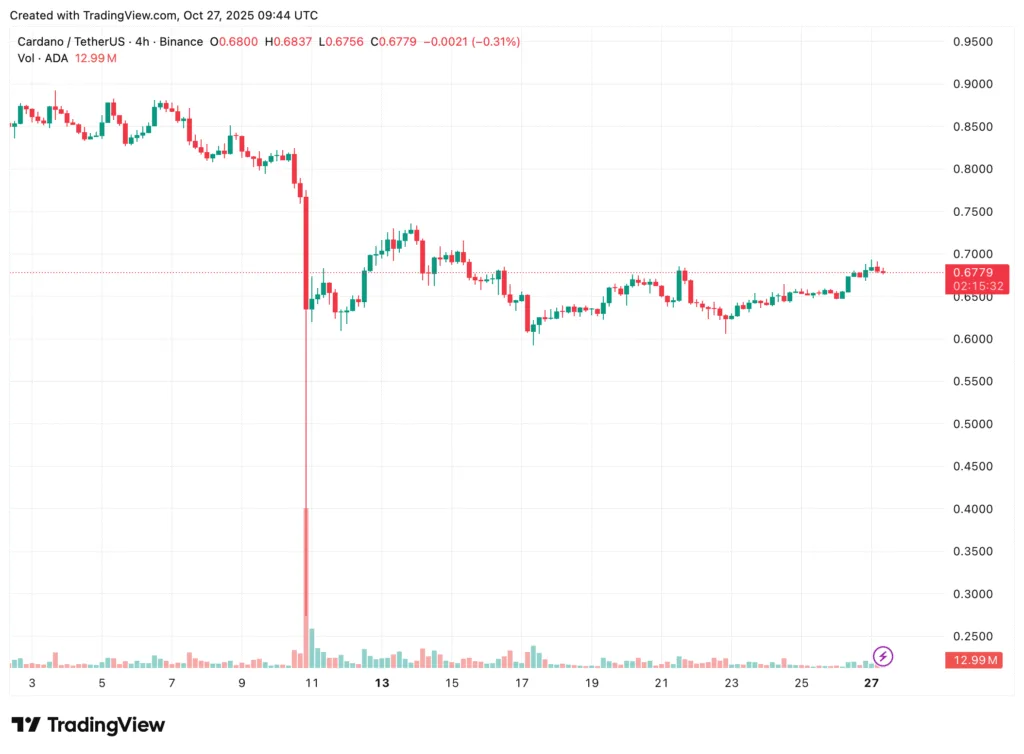
Market overview
Cardano’s path in October 2025 showcases the network’s gradual yet intentional development into a multifaceted platform. Trading at approximately $1.28, ADA has shown strength despite market volatility, supported by continuous ecosystem growth and the persistent uptake of Cardano-based applications. In contrast to Ethereum and Solana, which attract interest with their transaction capacity and DeFi engagement, Cardano’s value lies in strong governance, academic foundation, and enduring sustainability.
This month, ADA saw a modest increase of 6%, indicating growing faith among developers and investors that Cardano’s systematic strategy is starting to produce real benefits. The network’s distinct model, which integrates proof-of-stake security, formal verification for smart contracts, and decentralized governance, consistently draws projects that value reliability and compliance more than short-term innovations.
Market participants seem to be accepting ADA not as a speculative tool, but as an infrastructure asset that is expected to support usage growth over time. Its emphasis on practical applications, ranging from tokenization of supply chains to decentralized identity solutions, has consistently broadened its target market beyond mere financial speculation.
Technical structure
Cardano’s price trend throughout October has been marked by a positive consolidation pattern. Following the test of the $1.20 support level in early October, ADA has steadily established higher lows, creating a slowly ascending channel with resistance around $1.32. This framework indicates continuous buildup and regulated upward force.
Shifting averages support this perspective. The 50-day EMA has started to move above the 100-day EMA, indicating initial signs of bullish momentum, while the 200-day EMA stays significantly below the current trading price, reinforcing the overall long-term trend. Technical indicators like the RSI are presently at 55, suggesting a balanced market situation with potential for advancement before reaching overbought levels.
Volume trends indicate consistent involvement instead of speculative surges. The majority of trading in October is focused around the $1.25–$1.28 range, indicating a steady accumulation by retail and institutional investors. The presence of an ascending support line and a narrow trading range suggests a possible breakout if overall crypto market conditions stay positive, especially the momentum of Ethereum and Bitcoin, which typically affects ADA’s price direction.
On-chain metrics and network health
Cardano’s on-chain information highlights a network that is consistently evolving into a functional layer for decentralized apps. Daily active addresses have climbed to more than 400,000, reflecting a 12% rise since September. Participation in staking is incredibly high, with over 74% of the circulating ADA secured in staking pools. This significant stake ratio not only diminishes circulating supply but also enhances network security and stability, establishing a trustworthy base for future expansion.
Transaction throughput has gradually enhanced with the adoption of Hydra Layer 2 channels, allowing for off-chain scaling while maintaining the security of the base layer. Hydra enables Cardano to handle thousands of transactions every second with minimal congestion, making ADA an attractive choice for large-scale business applications.
Additionally, Cardano’s ecosystem has experienced a significant rise in DeFi and NFT engagement, although this is on a smaller scale compared to Ethereum or Solana. Platforms such as SundaeSwap and Meld are starting to incorporate more sophisticated lending and synthetic asset offerings, while NFT initiatives are concentrating on practical applications, including digital certificates for supply chain management and educational credentials. These advancements indicate a move from speculative interest to practical implementation, in line with Cardano’s overarching goal of academically supported, enterprise-level blockchain infrastructure.
Governance and ecosystem development
The academic and research-focused development philosophy of Cardano continues to be fundamental. Projects that receive formal verification and peer review are prioritized within the ecosystem, guaranteeing long-term dependability. Collaborations with universities and research organizations have also grown, establishing a pathway for innovative solutions in fields like supply chain verification, decentralized health records, and sustainable finance initiatives.
Additionally, the Hydra scaling solution is attracting developer attention due to its low-latency transaction capacity and modular design. This makes Cardano an attractive platform for enterprises seeking secure, high-throughput blockchain infrastructure without compromising governance and regulatory compliance.
Market sentiment and liquidity dynamics
Market sentiment regarding ADA has stayed positive yet cautious. The lack of speculative excitement has fostered a setting where institutional investors are at ease deploying capital. ADA exchange reserves have seen a minor decline throughout October, suggesting accumulation instead of liquidation, while staking pools still secure most of the circulating supply, thereby decreasing immediate selling pressure.
Liquidity indicators show steady order book depth between $1.25 and $1.28, with resistance focused around $1.32. The futures and options markets are still comparatively shallow when placed alongside Ethereum and Bitcoin, indicating ADA’s commitment to sustainable growth rather than short-term leverage trading. Social sentiment data indicates a moderate yet positive engagement, especially concerning protocol updates and governance proposals, suggesting a community more focused on the platform’s functional growth rather than speculative price fluctuations.
Outlook and forecast
Looking forward, Cardano’s perspective for November is one of cautious optimism. Sustaining support around $1.25 while challenging resistance at $1.32 may initiate a slow climb toward $1.40 if macro conditions stay positive. ADA’s long-term prospects are influenced more by its capacity to provide functional, enterprise-level solutions and sustain strong staking involvement than by short-term price increases.
Through continuous Hydra Layer 2 implementations, vibrant governance, and increasing adoption of DeFi and NFTs, Cardano is strategically positioned to achieve its scholarly goals in real-world applications. Its systematic, research-based strategy might not lead to dramatic price changes, yet it creates a solid groundwork for long-term growth and ecosystem resilience.
Essentially, the narrative of Cardano for 2025 is characterized by practical maturity. It has transitioned from a mere experimental protocol to a secure, scalable, and governance-focused blockchain that can accommodate actual enterprise and societal uses. The network’s consistent speed, along with its strong technical and governance structures, indicates that ADA will continue to be a fundamental part of the Layer 1 ecosystem well into 2026 and further.













